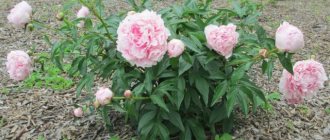The tree peony has incredible beauty and the power to fascinate others. Its delicate petals contain the perfection that only nature can create. Peony is one of the most ancient plants on earth, glorified in legends and endowed with magical properties. In Ancient Greece they believed that peony was able to protect people from evil spirits, and in China this flower became the favorite of the emperor and the nobility. It was the Chinese who began to actively develop new varieties of tree peonies, which gradually began to gain popularity in different parts of the world. All of them amaze with their extraordinary beauty and richness of shades, symbolizing pure love and prosperity.
In modern gardening there are a huge number of varieties of tree peonies.
What is and what does a tree peony look like?
The height of the tree peony (photo of the bush) usually reaches from 1.5 to 2 meters. Dense stems are directed vertically and covered with light brown bark. With age they become thicker and stronger. The stems are decorated with unusually shaped feathery leaves that resemble lacy green lace. On the outside, the leaf plate is painted in a rich green tint, and on the reverse side the surface acquires an original purple tint.
Tree peony is a fairly powerful deciduous shrub.
At the tops of the shoots, buds are formed, which over time turn into large double or semi-double flowers (with a diameter of 12 to 20 cm). Thin, soft petals are painted in the most incredible shades. Here are various tones of purple, pink, red, yellow. Two-tone specimens with iridescent gradient coloring look especially impressive.
Attention! The older the bush, the more buds ripen on it.
With proper care, up to 70 lush flowers bloom on one adult plant. Each of them pleases with its beauty for 14-21 days. Afterwards, star-shaped fruits appear on the bush, which can be eaten. Together with roots and buds, they are used in folk medicine. Delicious teas, tinctures, wine, jam and cosmetics are prepared from the petals.
What is the difference between a tree peony and a regular one?
You can first distinguish a tree peony from a regular one by its appearance. The herbaceous species is a traditional garden flower with thinner and more graceful stems. For the tree-like variety, the name speaks for itself - it is a full-fledged, rather tall and spreading shrub with strong branches. Another feature of it is its resistance to cold. With the arrival of autumn, the foliage completely falls off, and the shoots continue to grow and get stronger, so that in the spring the plant becomes even more luxurious and strong. Herbaceous specimens do not tolerate cold weather at all, and their stems die at low temperatures.
The tree peony bush can withstand an abundance of large flowers
There are also differences in flowering. The tree peony blooms no earlier than 4 years from the moment of planting, or even later. For its grassy relative, this period does not exceed 1 year. The first buds of the tree peony are not cut off, as they do not inhibit the further development of leaves and shoots. This powerful giant is a true long-liver and is able to actively grow and develop in one place for 50 years, without replanting.
Read more When and how to prune peonies correctly in the fall
Transfer
Purple peony flowers can be replanted as a whole bush or rhizomes divided into parts. When the plants are planted in the holes prepared for them, the bushes are sprinkled with earth. The soil surface is mulched with a layer of at least 7 cm. This layer will need to be removed in the spring. At this time, young red shoots will appear on the surface.
For 2 years, the transplanted plant will tirelessly form roots. Therefore, flowering should not be allowed at this time. All buds that form on the bush will need to be removed immediately. Flowering takes a lot of energy from the bush, which can cause it to die. In the second year, only 1 bud is left on the branches. When it blooms, it is cut as short as possible.
This procedure will allow you to evaluate the appearance of the flower and how well it matches the variety. If the buds do not have characteristic features, they are also completely cut off in the third year. This is done until the plant is able to produce inflorescences of the appropriate shape and color.
Purple peony sometimes takes a long time until after replanting it is possible to produce buds of the appropriate color. This can happen either in the third or sixth year.
Types of tree peonies
In China, all varieties of peonies are divided into many groups based on the names of the provinces in which they were bred. In world practice, a different classification has been adopted. It includes three large groups:
- Sino-European. This includes varieties with large flowers that consist of large petals. They can be in completely different shades: from light pink to rich fuchsia. The too large size of the buds causes admiration, but at the same time they quickly droop and no longer look so beautiful.
Tree peonies of the Chinese-European group are distinguished by large flowers - Japanese. Local breeders have developed original varieties with aerial flowers slightly smaller than those of the representatives of the Chinese group.
In their shape, the flowers of the Japanese group of peonies are similar to a bowl and are semi-double - Hybrids. The ancestor of all these varieties was the Delaway peony, which was crossed with one of the yellow species. Representatives of this group are particularly beautiful, as they subtly combine different shades.
Hybrid groups of tree peonies are distinguished by their unusual petal shapes
Cuttings
This method is most often used by gardeners. For propagation by cuttings, semi-lignified shoots are used, from which sections with 1-2 large buds and a leaf are cut off. Pre-prepare the container by filling it with a mixture of peat and sand in equal proportions. Cuttings are planted in it, deepening them no more than 1.5-2 cm, and covered with glass or transparent film. They require regular moisture and ventilation.
Rooting occurs quite quickly and after 1-1.5 months the first leaves appear on the shoot.
At the end of September, the shoots with roots are planted in individual containers and grown in warm conditions until spring. When stable heat sets in, when the soil warms up to +10-12° C, young peonies are planted in open ground.
The best varieties of tree peonies
Every year more and more hybrid peonies appear. Each new variety amazes with its brightness, splendor and incredible aroma. But among the thousands of varieties, there are those that gardeners love more than others.
Coral Altar (Shan hu tai)
These rich neon pink flowers have quickly become gardeners' favorites. Tall bushes (about 1.5 m) are decorated with beautiful flowers with thin petals of an original shape. They exude a pleasant, sweetish aroma, reminiscent of delicate, expensive perfume. The bushes are very resistant to various pests and diseases, have no special requirements for soil composition, but for active flowering they need a lot of sunlight.
The red altar is distinguished by its rich color and spherical shape of the buds
Green Jade
A delightful, exotic peony with lime-colored petals. Spectacular bushes have strong stems with strong bark. The variety is fast-growing; it needs hot summers and cold winters, so that there is a contrast in temperatures and a clear change of seasons.
Green Jade has an unusual color and light aroma
The Qiao Sisters (Hua er qiao)
Another unique variety that combines two completely different shades: rich purple petals interspersed with a hint of pink lace. One flower has a diameter of up to 16 cm and can have a different number of petals of one tone or another. This variety is light-loving, grows well in alkaline soil and takes root in different climatic conditions. Bushes with two-color buds are rarely affected by any diseases and do not require special care.
One bud of Sister Kiao contains petals of both rich and very delicate shades
Propagation by seeds
Purple peony can be propagated not only by dividing the bush, but also by seeds. It is worth noting that often this method does not allow preserving species characteristics. This method is most often used by breeders.
The disadvantage of propagating peonies by seeds is the long period that passes from the appearance of the first shoots to the formation of buds. It can be about 4 years or even more.
If the gardener wants to experiment, he should sow the seeds on the site in August. The soil is pre-loosened. The first shoots will appear next year in the spring. The bushes develop quickly. They will bloom at the end of May or June. Although there are also late varieties. They can bloom in July.
Winter-hardy varieties of tree peonies
Winter-hardy varieties of tree peonies are in demand in the Siberian and Far Eastern regions. This is due to good resistance to soil freezing (up to half a meter) and intensive growth (more than 20 centimeters per season).
Winter-hardy varieties do not differ in flowering time
White Phoenix (Feng Dan Bai)
Milky petals with a faint pink tint and golden stamens contrast favorably with the unusually shaped leaves of a deep green hue. The flowering period lasts about two weeks.
More details Tree peony: cultivation and care, when to replant, photos, videos
White Phoenix, even after flowering, does not lose its attractiveness due to the interesting shape of the leaf plates
Spring Willow Chun Liu
Every gardener dreams of having such a variety in his collection. The flower simultaneously combines several shades: light green with a transition to pale yellow, and crimson splashes appear at the very base.
Chan Liu flowers have fairly dense buds and look fresh in spring
Red Wiz Pink (Red With Pink)
Incredibly beautiful bicolor with unusual buds. These colors alternate with each other in broad strokes, as if left by the artist’s hand. Each flower resembles a bowl made of the finest porcelain, painted by a reverent master. The plant is famous for its unpretentiousness and ability to withstand extremely low temperatures (from -30 °C or more).
Red Whis Pink has wavy edges and vibrant petals in cherry and pink tones.
By layering
The procedure is recommended to be carried out in May. In the lower part of the bush, a developed and flexible stem is selected, lightly cut, treated with a means to stimulate root growth and tilted to the ground. The places of the cuts are sprinkled with soil to a depth of 8-10 cm, and the branch is fixed in this position with wire.
The branches are watered regularly. In 3-4 months, independent roots grow on the layering. They are carefully separated from the mother culture and replanted separately.
Some gardeners do not cover the cuts with soil, but wrap them with sphagnum moss and then with plastic wrap. Due to maintaining constant humidity and the greenhouse effect, roots also form in the cut area.
Varieties of yellow tree peonies
Yellow tree peonies appeared relatively recently. For a long time, breeders were unable to achieve stable varietal color.
Yellow tree peonies do well in loamy soils.
Sunrise
A popular American hybrid with an almond butter shade and a very fine border around the edges. It gives the flower visual splendor, making it look like an airy marshmallow. Each petal curves gracefully.
Tree peony Sunrise has a beautiful center with rich yellow stamens
Kinko (Jin ge)
It amazes with an amazing fusion of warm, summer tones: creamy color turns into pumpkin, and in some places additional pink tints appear. The petals are so delicate and transparent that they appear to be painted in watercolor. Massive flowers hang slightly from the stems, bending under their own weight.
The Kinko tree peony has massive spherical flowers.
Kuinji
A rich yellow variety, as if dozens of small, gentle suns suddenly blossomed on one bush. On the outer surface of the petals at the very base there are noticeable spots of almost black color. This variety is afraid of waterlogging of the soil.
Cup-shaped Kuindzhi flowers bloom relatively late, but very quickly
Academician Sadovnichy
An amazingly beautiful variety of peonies, the petals of which have a yellow-peach tint adjacent to a rich purple spot at the base. Semi-double cup-shaped flowers immediately attract everyone's attention with their special radiance and grace.
The Academician Sadovnichy flower is distinguished by large petals with jagged edges
Recommendations for planting
The violet tree or herbaceous peony must be planted correctly in the ground. When choosing a site where a flower will grow, you need to take into account that the length of the roots reaches at least 70 cm. Therefore, after the plant is more than 5 years old, replanting it to a new place will be extremely problematic.
Peonies grow well in well-lit areas. The bush grows well if it receives direct sunlight for at least 5 hours during the day, preferably before lunch. The plant absolutely does not tolerate drafts. Therefore, you need to choose protected places for planting.
You should not plant bushes in lowlands. Here moisture can stagnate. This can cause the roots to rot. It is best to choose loamy soil for planting peonies. It should have an acidity of 6-6.5 pH. Sand and humus are added to soil that is too clayey or dense. Sand, wood ash and organic fertilizers are added to peat soil.
Varieties of purple and lilac tree peonies
This unusual color invariably attracts attention. Large flowers are arranged in a cluster and look impressive. Such plants are the highlight of any garden.
Purple and lilac tree peonies have an unusual color and large buds.
Imperial crown
Flowers of the Imperial Crown variety really resemble the crown of a monarch in shape. Cardinal-colored petals with a purple tint are raised upward, and the stamens appear to be covered with thin gold. In the sun they shimmer with hundreds of luminous sparks, like jewels. The key to generous flowering will be reliable shelter in the cold and proper care in the hot season.
Imperial Crown - a spectacular variety with large flowers
Deep Blue Sea (Da Zong Zi)
The flowers of peonies of this variety are painted in raspberry-coral shades and against the background of lush, carved foliage they seem even more voluminous. Each petal is a small perfection captured in a unique form. Even after flowering, the bush remains attractive.
The deep blue sea pleases the eye until the first autumn frosts
Purple Ocean (Zi Hai Yin Bo)
This incredibly large flower blends deep purple and plum colors together. White strokes are applied to the petals as if with the thinnest mascara brush. Against the background of the overall gouache coloring, they look very gentle and make the flower look fatal and at the same time vulnerable and defenseless.
More details Peony Bartzella: photo and description, reviews, care
Tree peony Purple Ocean has an exquisite spicy-fruity aroma
Preparing for winter
Preparations for wintering the purple peony begin as soon as the foliage turns yellow. In order for the bush to accumulate strength for this process, it is necessary to remove all faded buds after flowering. Half a month after this, you need to feed the bush with potassium and phosphorus fertilizers. It is necessary to water the plant systematically. This way it can develop properly and prepare for winter.
When the shoots and leaves begin to turn yellow, reduce watering. But this needs to be done gradually. When frosts begin, the part of the peony that is on the surface of the soil is cut off. There will be practically no stems left.
If the peony was replanted this year, you need to mulch the soil. Under a layer of peat or other suitable material, cut shoots should not be visible.
If the plant is young, a shelter is created for it. This way frosts will not be able to damage fragile roots. This is not required for adult peonies. These simple steps will help prepare the plant for winter. The varieties that are cultivated in our country tolerate fairly severe frosts.
By following these recommendations, you can grow a beautiful plant yourself. A bouquet of purple peonies will look charming. Also, shrubs planted on the site can decorate the landscape design, giving it coziness. By choosing the right variety and providing the necessary conditions for it, you can get a plant with unusually beautiful flowers. They can have a wide variety of shapes and shades from soft lilac to deep purple.
Varieties of pink and red tree peonies
The peculiarity of pink and red peonies is that each variety has an individual shade, unlike the others. The most delicate color and pleasant aroma have made them popular in all corners of the world.
Flowers of pink and red tree peonies have wide, rounded petals
Lantian Jay
An unusually beautiful chalk pink peony with many wavy petals. The flowering process begins at the very beginning of summer, and the garden is filled with a sweet, subtle aroma.
Lantian Jay is shaped like a beautiful pompom
Shima Nishiki (Shima-nishiki – Dao Jin)
An amazing creation of Japanese breeders. This variety appeared due to a natural mutation of the Tayo peony. As a result, the world saw a real masterpiece, consisting of almost white petals generously colored with cinnabar. Stripes and strokes of different widths intertwine with each other, forming natural patterns. In addition to the variegated one, this variety also has a completely monochromatic variety, which amazes with its rich red hue.
Shima Nishiki has about two dozen buds on a young bush
Rose powder (Fen he piao jiang)
Breeders managed to reproduce the shade of a delicate pink pearl, which shimmers, changing the depth of tone. The fragile beauty of this peony makes the heart skip a beat, and its ease of care makes this variety the most desirable among gardeners around the world.
Tree peony Pink powder feels good in Russian latitudes
Pest and disease control
The most dangerous enemy of tree peonies is the mosaic virus, which will rapidly spread throughout the garden. There are several different mosaics, and some of them can spread from cucumbers or other seedlings. The leaves and petals are covered with necrotic spots, and the disease itself cannot be treated.
In the same way, Lemoine's disease, due to which peonies become smaller and grow poorly, cannot be treated. Otherwise, there is a standard set of fungal infections that need to be combated with fungicides and humidity adjustments. If affected by rust or spotting, quickly cut off all damaged leaves and burn before the infection spreads further.
Peonies do not have many pests: aphids, slender weed caterpillars, bronze beetles. The sweet juice of the buds attracts ants to the garden, and the developed root system becomes a refuge for nematodes. The fastest and most effective method of control is spraying with insecticides.
Photo: 2sotki.ru
Tree peony in landscape design
There is hardly another shrub that can compare in the perfection of lines and riot of colors with the tree peony. This incredible plant gives complete freedom for flight of fancy and allows you to realize any idea. An ordinary garden plot turns into a fairy-tale garden, worthy of becoming the decoration of a real palace. Peonies are often used to decorate parks and squares to create elegant and formal compositions. As part of the garden, the tree peony (pictured below) will help recreate the atmosphere of an ancient park if you install beautiful wrought iron benches and original street lamps.
Tree peonies can be planted near open gazebos and swings
Attention! Spreading shrubs should not be planted as a solid wall, otherwise they will lose their charm.
The tree peony is a born soloist, and not every plant can make a successful duet. It is best to place a majestic silver spruce or bulbous flowers (crocuses, daffodils, tulips) next to it. Peonies will look spectacular against the background of various decorative elements, such as garden statues, small fountains, as well as beautiful architectural structures. Bushes can be planted near open terraces so that you can enjoy the beauty and delicate aroma of these amazing flowers while having leisurely conversations and drinking tea.
Dividing the bush
To carry out this procedure, you can use plants that are more than 5-6 years old. It is advisable to combine it with anti-aging pruning (at the root) or replanting. The mother bush is dug up and manually divided so that 3-4 buds remain on each part. The optimal time for such work is August.
Ready seedling
The best planting option with the least hassle is purchased seedlings from a nursery with a good reputation, which take root well.
It should be noted that seedlings of tree peonies can be either self-rooted or grafted, i.e. obtained from a herbaceous relative. Each type has its own advantages and disadvantages.
Self-rooted peonies have a longer lifespan and are highly resistant to frost and disease. They can be propagated from the mother culture. The main negative is slow growth and development, which leads to their flowering only in 4-5 years of life.
Grafted peonies are characterized by rapid growth and the beginning of flowering in the 1st-2nd year of life. At the same time, it is impossible to obtain offspring from them using classical methods, but you can dig up shoots near the bush for further planting. They are less resistant to various negative factors (cold, disease, pests, etc.).
Vaccination
For this purpose, in early August, cuttings with two buds are cut from the tree peony and sharpened at an angle in the shape of a wedge. The object for grafting is the roots of the herbaceous peony, in which a similar hole is made for the scion. The place where they join is tightly wrapped with garden or grafting tape and placed in a container with moistened sawdust, which is covered with film. This structure is placed in the shade (partial shade) for a month.
After this time, the rhizome is planted in a container in a position so that the eye is at the bottom at a depth of 5-7 cm, and transferred to the greenhouse.
Growing a tree peony this way takes an average of 1.5 – 2 years.
Trimming
For tree peonies, pruning is a mandatory procedure. It is recommended to start it already from the second year of the plant’s life, both in the spring before the buds begin to open, and in the autumn. The correctness of its implementation affects the lifespan of the culture.
In addition, certain manipulations are performed with the buds to ensure lush flowering. This removes:
- wilted flowers, so that the plant’s energy does not go to the formation of seeds, and also to avoid the development of various diseases;
- only the blossoming buds of a young bush (the first year of flowering);
- side buds to stimulate the growth of larger upper flowers;
Scheme for pruning a tree peony
Sanitary pruning in the fall consists of removing damaged, dried and rotten stems. In the spring, lifeless areas identified during additional inspection are also eliminated. In addition, weak shoots are cut out so that they do not take away the strength of the plant. At the same time, you need to be careful about frozen branches, which quite often “depart” and put out buds.
Thinning pruning is carried out if necessary to remove stems that thicken and disrupt the structure of the peony. This way improves the aesthetics and ensures access of air and moisture inside the bush. The procedure can be carried out both at the beginning and at the end of the season.
Anti-aging pruning comes down to significantly cutting off old (woody) shoots, leaving 10-12 cm of them. It is advisable to carry out this procedure in the fall in order to ensure normal growth and flowering in the renewed areas next year.
According to the advice of Chinese flower growers, radical anti-aging pruning must be done once every 15-20 years. In this case, all stems are removed to ground level, which helps awaken the adventitious buds located at the base of the shoots. This pruning gives a powerful impetus to the growth of the bush. At the same time, you can combine the procedure of dividing the mother bush. It is dug up and divided in such a way that 3-4 buds remain on each part.
Formative pruning is carried out in the spring after the buds awaken. Weak and twisted shoots are significantly cut to a height of 10-15 cm, and the rest - to the first growth bud. At the same time, the optimal height for the bush after pruning is 70-80 cm.











